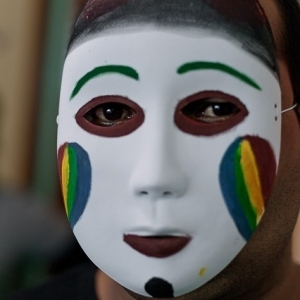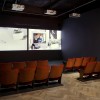As diverse as they are bright, we see tri-color flags, love hearts on cheeks, and green eyebrows with striped patterns. One mask looks like a Japanese manga hero mask. The array of color and shapes creates a feeling of joy; a sensation that is somewhat confusing, as refugee experience and joyfulness are not an intuitive pair. It is here my knowledge of theater comes in handy.
During a drama workshop, we were instructed to intimidate a chosen student. Knowing well that it was a game, it took us a while to assume the character of ‘the bully.’ “There!” yelled our instructor, leaping forward with a mask on his face: we had succeeded in scaring the poor boy, reducing him to the corner of the room.
Masks have a very long history in Western theater. In ancient Greek theater, masks had a literal function: to indicate a switch of identity or physical state. A small number of actors can then act as multiple characters within a play. Now, masks are used more for training purposes, as a way to explore the inner psyche of characters. The “archetype masks” explore the major types of people commonly found in a play. To name a few, we have “the hero”, “the victim”, “the mother”, and “the trickster.” The mask we were using, needless to say, was that of “the victim”. This would not be as obvious if the mask was not stuck onto a victimized person. The masks, observed on their own, do not look that different from one another. You can probably tell apart “the hero” and “the victim”, but the difference between “a mother” and “a trickster” may not be that obvious. From here, it is body language that steers us in the right direction: human emotions manifest not only via facial expressions, but also through your whole body without you necessarily realizing. The victim mask only did its job because our poor classmate was placed into the position of the victim: his body language unleashed the full potential of the mask to create the perfect victim.Without it, the mask was just a piece of distorted cardboard.
The exhibition’s colorful masks may then not be telling the whole story. Fortunately, the curators of the exhibition know that well. In addition to the masks, the exhibition features photos of their creators living their lives in Hong Kong with the masks on. The “manga hero”, upon its creator “Shirley”, a mother from Sri Lanka, tells a story of despair. The black strip in front of her eyes represents the darkness which blinds her future. The mask with sweet-hearts on the cheeks fits onto two little girls, and tells a story of distrust. The mask with wounds on the head and blood in the nose comes to life when their creator, Nelson, puts it on and sits blankly looking out of the window. The brown mask that looks quite plain on its own becomes frantic when put on by its creator, a purged goldsmith originally from Africa eager to put his life into motion again. When Robert, a young Boy who fled Sri Lanka because he was abdicated by the Tamil Tigers as a child soldier, puts him tri-color mask on, his body is in a state of combat –even in a safe society like Hong Kong. Each creator’s body tells a story: trauma of the past, and confinement of the present.
Trauma of the past is not hard to understand. But isn’t life supposed to get better now that they are in a place with no war and open violence? Why then does their body language not convey a sense of hope? To date, Hong Kong has a dual system screening applications from refugees. Both systems do not allow the person to settle in the city. If a refugee’s status is confirmed by the United Nations High Commissioner to Refugees (UNHCR), he or she will then wait to be transferred to another country, usually the USA, Canada, France or Sweden, where citizenship may be granted. This process of application can take up to a decade or more. On the other hand, a refugee can be offered protection in Hong Kong under the Convention Against Torture (CAT). In this case, the person can remain in the city instead of getting deported. Yet the government with neither offer resettlement to other countries, or allow the successful CAT claimant the right to work, residence, education or welfare in Hong Kong.
Under any condition, refugees in Hong Kong are not allowed to work or undertake voluntary positions, no matter how long they stay. As a result, they rely on assistance to live. They collect food from designated shops every 4-10 days, and receive a housing subsidy of around 1200 HKD (about 100 GBP) per month. Constantly ranking top three in the global rental market, finding a cheap place to stay in Hong Kong is no easy job. This amount of money is shamefully insufficient. Ms. Irene Chan, Community Organizer of Society for Community Organization (SoCO), curator of the exhibition, recalls a recent case where two refugees remain homeless until a landlord agrees to rent out his flat for cheap because someone has committed suicide in it. As such, most refugees are put in a very isolated condition. It’s as if we say, “We are not turning you away because we shouldn’t. But we are not giving you a life because we don’t have to.” What strikes me is not that we leave them in material poverty, but a void which makes integration impossible and interaction minimal. We have decided to strip life of its fundamental elements.
“I came as a young man and now I’m in my middle age. I wish I could do something useful with the rest of my life,” said Peter, a priest who was driven out of his home in Africa after openly opposing the government. “10 years of youth and vitality spent in waiting. I won’t be able to tell, because it looks all the same behind the mask.”













